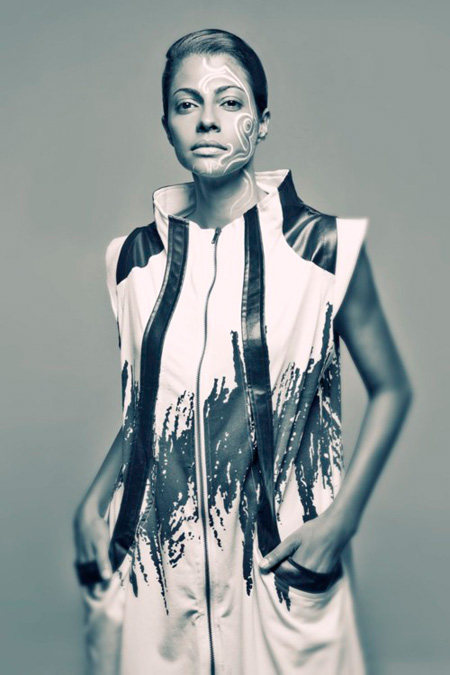Carl Jung, Swiss psychiatrist and founder of analytical psychology, first gave us the concepts of the ‘anima’ and the ‘animus’. According to Jung, each individual has both masculine and feminine components of the psyche.
For a male the feminine component is the anima, and for a female it is the animus. Part and parcel of human biological and psychological development is this mixture of masculine and feminine energies. The anima and animus draw their power especially from the collective unconscious, but they are also conditioned by a person’s individual experiences.

SoFake: Bringing androgynous fashion to your closets. Photograph by Joy Datta.
The word ‘androgyny’ has been derived from the Greek word ανήρ (anér, andr meaning man) and γυνή (gyné meaning woman). Androgyny is seen in both the plant and the animal kingdoms. It can be seen in fashion, in sexual identity, or even in sexual lifestyles. An androgyne is a person who does not fit into the typical masculine or feminine roles of his or her society.
Fashion has always sought to create something never seen before and androgynous fashion has done much to bring acceptance and popularity to sexual and gender crossovers. Right from showgirl Louise Brooks’ bob hairstyle in the early 1900s to designers Helmut Lang, Giorgio Armani, and most recently the much loved Miss J. of America’s Next Top Model, androgyny has been a constant favourite of the fashion world. Stars of popular culture like Boy George, Prince, Annie Lennox, Michael Jackson, Madonna, Lady Gaga, and Adam Lambert have all brought androgynous fashion to our living rooms.
And now Sapna Bhavnani and Sukriti Grover plan to bring it to your closets.

SoFake founders Sapna Bhavnani and Sukriti Grover. Photograph by Arijit Datta.
SoFake is the newest fashion brand on the shelves, and partners-in-crime Sapna and Sukriti have created a very minimalistic yet structured harmony in monochrome. City barber and hairstylist to the stars, Sapna Bhavnani is always seen wearing men’s shoes, loves her motorcycles, and has a distinct boy-meets-girl look. In a city which is all about Bollywood, perfectly manicured nails, and wardrobes handpicked by stylists (which, even at their best, can’t be a personal expression of style), Sapna dares to walk out of her house each day dressed exactly the way she wants, as exactly who she wants to be. It wasn’t always easy for her to walk the streets of Mumbai in her short skirts, but she has come a long way from the taunts of neighbourhood boys to being accepted and loved by so many today. “The look of SoFake stems from all things unisex. I love wearing boys’s clothes and love boys who wear women’s clothes. Hence we decided to make shopping easy for couples so people can now buy one set of clothes that fit both the man and the woman.”
much cooler!”
The name of the brand will prompt the instant question: what is so fake about these clothes? Sapna explains, “SoFake is derived from my surroundings where everything I see is fake and artificial and it’s so rare to find genuine people.” A little bit more probing brings us to the other very interesting dimension of this clothing brand. The name may have been inspired by the characteristics of the people in her environment but the ethical foundations of the brand are also ‘so fake’—but in a good way.

A model shows off a SoFake creation. Photograph by Manoj Jadhav.
The brand does not use any fur or leather or anything derived from animals. Sapna supports the animal-friendly approach to life, which suggests that sometimes its cool to fake it—faux fur, faux leather, and faux silk are a more compassionate approach to fashion, and the animal lover in her will not allow her to use animal products in her clothing line. In the past, Sapna has spoken up for animals in an ad for P.E.T.A. India, urging the government to end dissection of animals in universities. The campaign ended in a victory for animals and very soon animal dissection in laboratories at the college or university level will be a thing of the past.
SoFake recently showcased an avant-garde collection at Lakme Fashion Week. “The runway scene was a high that is very difficult to forget. The experience of the buzz and the rush are still within us. But tackling the nitty-gritties is irritating to creative people like Sukriti and I. It’s a bit weird for us to call people and try to sell our stuff, but I guess we have to learn. The multiple jobs are beautiful to keep the creativity going—I love that about my life! It’s the selling and the marketing that irritate me.
“A lot is happening with SoFake. Our new spring/summer collection has just hit the stores and we have been getting good reviews. We decided to dabble in prints this time but kept the black-and-white element alive. From the drama on the runway to the stores—the journey has been beautiful. The kathakali-meets-Victorian era, a.k.a. the ‘Kathorian’ collection, is something that we are very proud of,” says Sapna.
This eccentric hairstylist has been a producer, a director, an actor, a photographer, an animal rights activist, and is now the proud owner of a fashion brand. What keeps it all together? “Hair, make-up, fashion, all go hand in hand. They are incomplete without each other,” says Sapna. Even though she’s stepped into the sparkly, yet sometimes murky world of fashion, Sapna firmly dismisses trends. “Trends are for people who have no vision. They have no definition of themselves and need external factors to help them blossom. Trend-breakers are so much cooler!”








